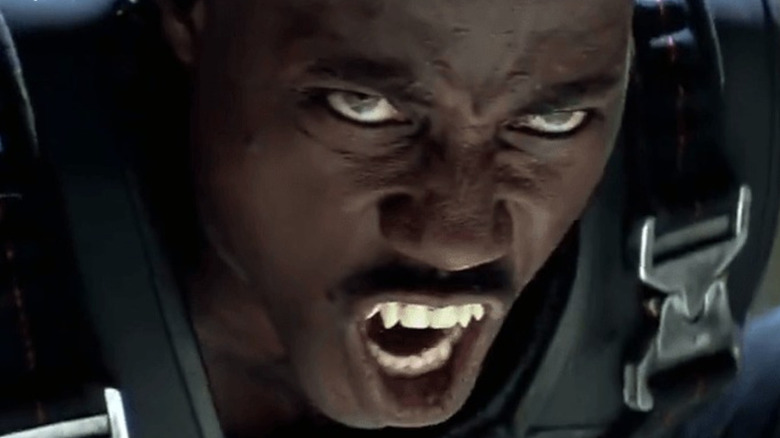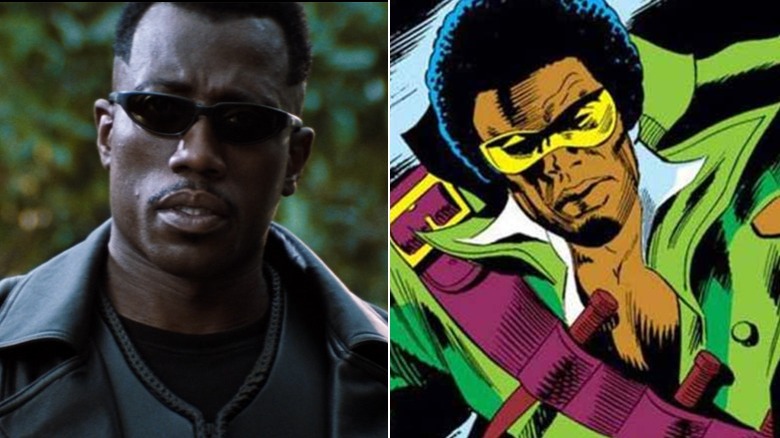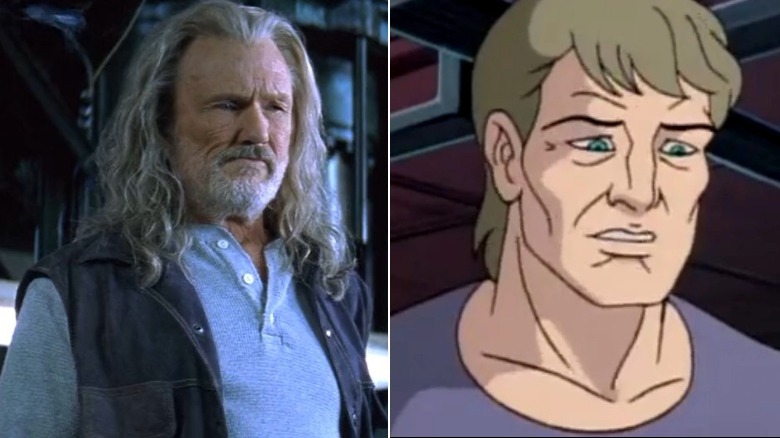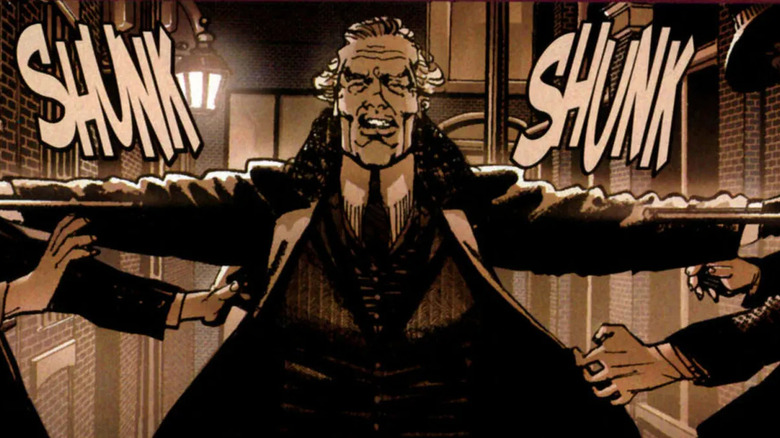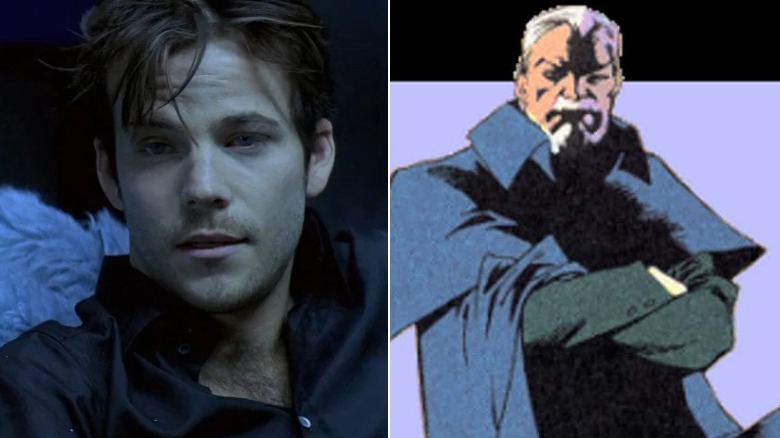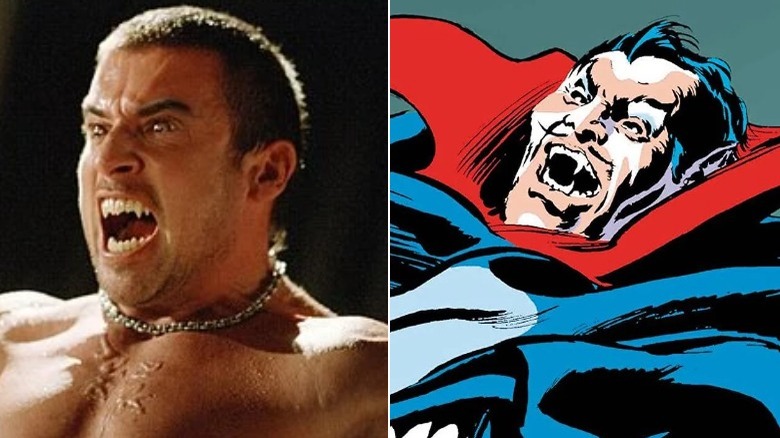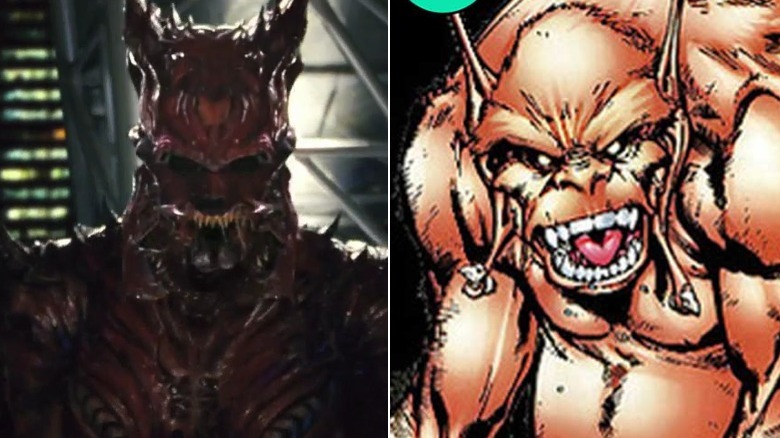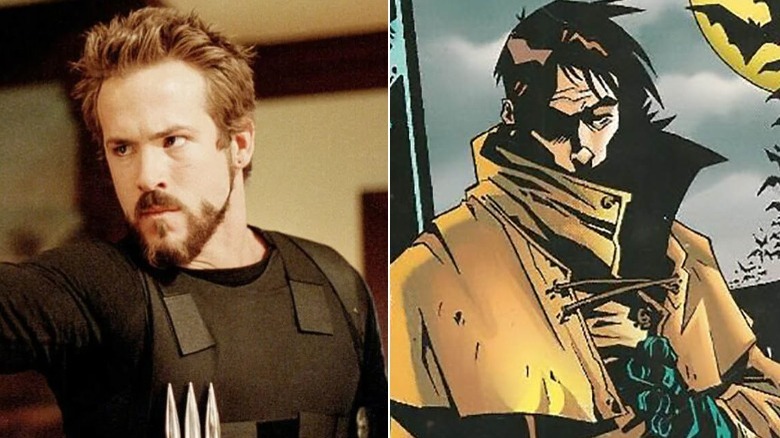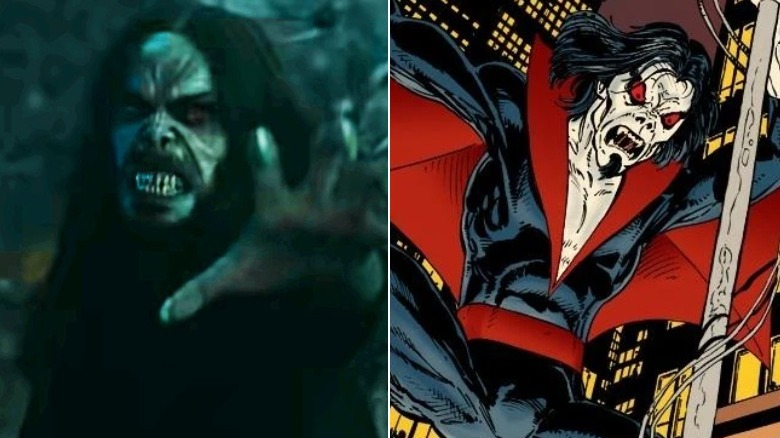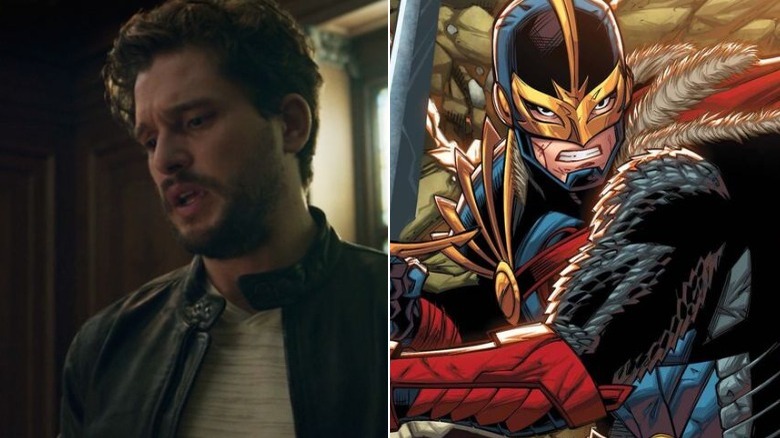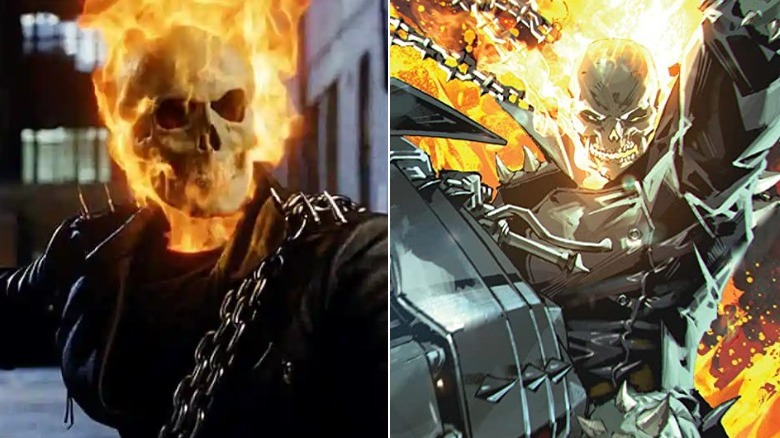How The Cast Of Blade Should Really Look
"Blade," directed by Stephen Norrington and starring action superstar Wesley Snipes, is one of the coolest movies ever.
The 1998 film introduced Hollywood to anime-inspired wire fu stunts, strobing goth clubs, and cool guys kicking butt in leather trench coats and sunglasses a year before "The Matrix." It is also the catalyst for the current domination of comic-book movies that we're experiencing today. Without "Blade," studios might not have taken a chance on producing a big-budget "X-Men" film in 2000, whose success led directly to 2002's "Spider-Man," which itself eventually led to the Marvel Cinematic Universe we know and tolerate today. In fact, Blade will be rebooted in the MCU pretty soon, played by Oscar-winning actor Mahershala Ali this time around.
However, the original "Blade" trilogy — consisting of the aforementioned "Blade" from 1998, 2002's "Blade II," and 2004's "Blade: Trinity" — makes a lot of changes to the character's original comic book lore. In fact, Blade being a daywalker — someone with the powers of a vampire but none of weaknesses — is a change from the comic books that was invented for the film and later added to Blade's comics lore. If any upcoming "Blade" project stays closer to the source material than the original trilogy, here's how the characters should look.
Blade
Blade, the iconic vampire hunter, was first introduced in Marvel Comics' "Tomb of Dracula" #10 in 1973. In his initial appearance, Blade wore an entirely '70s-style leather jacket, green pants, and green shades. His hair was also totally different, and drawn as more of a traditional afro, rather than the '90s-era flattop that Wesley Snipes sports in the three live-action "Blade" films. Of course, Blade's original comics design has a lot to do with the era in which those stories were produced, though Snipes could still rock that style and look like a badass without a problem.
Blade's original set of powers from the comics underwent an upgrade when it was time to turn him into a movie character. In the films, Blade has all the strengths of vampires — super strength, super speed, regeneration, etc. — and none of their weaknesses, like sunlight; hence the term, "daywalker." The "daywalker" conceit was an addition of the first movie's screenplay credited to David Goyer ("The Dark Knight"). In the source material, Blade's special ability is simply the fact that a vampire bite can't turn him into one. That's it.
No news yet on how Mahershala Ali will look in the upcoming Marvel Cinematic Universe reboot version of the character but seeing as how iconic the Wesley Snipes Blade is — i.e., the black leather trench coat, designer shades, and flattop — it's unlikely the new version will stray too far from that awesome design. But who knows? Like Snipes, Ali could still look cool donning the classic original green leather jacket and shades from Blade's comic book debut, which would be an interesting route for the MCU to take.
Abraham Whistler
Blade's tech guy and weapons expert Abraham Whistler is probably the most prominent character in the "Blade" franchise outside of the super-powered vampire hunter himself. He was played in the films by a charismatically crusty Kris Kristofferson speaking with a raspy, whisky-drenched Southern drawl and decked out with flowing mane of gray hair. However, as iconic as he is, Whistler actually didn't originally appear in the comics, nor was he an original creation of the films.
In fact, Whistler's first appearance was actually in "Spider-Man: The Animated Series" from the '90s, in the second season episode titled "Blade the Vampire Hunter." The character was first voiced by Malcolm McDowell, and then in subsequent episodes by actor Oliver Muirhead. The plot of "Blade the Vampire Hunter" involves Blade and Whistler helping Spider-Man take down a pre-meme Morbius. It's also worth remembering that since this is a kids' show, this version of Morbius grows pulsating suction cups on his palms and sucks "plasma" from his victims instead of blood, which is fine. It's just fine. In fact, it's great.
In "Spider-Man: TAS," Whistler is still Blade's older, wiser mentor, but he isn't nearly as gruff, nor does he sport the patented grizzly beard and long hair of his film counterpart. Astoundingly, Whistler still hasn't made a jump from celluloid to the comic book pages as of yet. But maybe Marvel comics will do something with the character to coincide with his presumable MCU reboot.
Jamal Afari
While Kris Kristofferson's grizzled vampire hunter Abraham Whistler is first introduced outside the comics, he's also never officially been in a canonical comic book issue. (Although he shows up in the movie tie-in comics.) This is because in the comics, Blade's mentor isn't Whistler — instead, it's jazz musician-turned-vampire hunter Jamal Afari.
Afari first appears in 1975's "Marvel Preview" #3. His backstory is similar to Whistler's in the "Blade" films, in the respect that he is introduced as an already experienced vampire hunter. In his introduction comic, Afari hunts vampires in the streets at night, but he gets overwhelmed due to his increasing age. Luckily, Blade — just a homeless 9-year-old orphan boy named Eric Brooks at this point — saves him. Afterwards, Afari takes young Eric and teaches him all he knows about vampire-hunting, turning the boy into the badass Blade we know and love today.
Now there are certainly similarities between Afari and Whistler, but there are also many differences. While Whistler is Blade's white mentor, Afari is a Black man, who — as mentioned above — was at one point an accomplished jazz musician. There's also the fact that Afari's drug habit is a major part of his character that he has to overcome throughout the series. Finally, both Whistler and Afari get turned into vampires as revenge against Blade; however, Whistler gets turned back into a human in "Blade 2," while Blade has to kill his vampiric mentor, Afari.
Deacon Frost
Despite the vampire-hunting anti-hero Blade premiering in "Tomb of Dracula," Blade's archnemesis is a different ancient vampire named Deacon Frost. This is why he was the obvious choice for a villain in the first "Blade" film — Frost is sort of Blade's answer to the Joker or Lex Luthor.
In 1998's "Blade," Frost is played as by Stephen Dorff as a younger, newly turned vampire who is more of a rich hipster club kid in contrast to the dour and business-oriented full-blood vampires who control the vampire underworld. This, of course, causes generational friction among the vampire hierarchy, which leads to the enactment of Frost's plan to use Blade's special blood and the souls of the captured vampire elders to become an unstoppable blood god.
The movie Forst is quite a bit different than how the villainous vampire is depicted in the "Blade" comic books. In the comics, Frost is an older, aristocratic vampire similar to the depictions of Dracula in popular media, save the dashing white beard, rather than Dorff's more modern interpretation. (In the case of Dorff's Deacon Frost, the term "modern" is basically a synonym for "'90s style.")
Dracula
Speaking of Dracula, as mentioned before, Blade's introduction in the comics occurs in Dracula's own Marvel title, "Tomb of Dracula," first introduced in 1972. Since Bram Stoker published "Dracula" in 1897, the character became a public domain intellectual property starting in 1962, 10 years prior to his Marvel Comics debut. This means Marvel didn't need to license Dracula in the same they've had to license characters like Godzilla, Conan the Barbarian, and Rom the Space Knight.
In the comics, Dracula is very similar to his literary counterpart; he's an aristocratic, suave, and pale-skinned human-looking vampire, wearing dark clothes and cape, similar in many ways to Deacon Frost. There are also some definite influences from other iterations of Dracula in the comic book version, such as Bela Lugosi from the 1931 film and Christopher Lee from the Hammer Films that started with 1958's "Horror of Dracula."
However, in "Blade: Trinity" when Dracula — or "Drake" as he's known in the film, played by Dominic Purcell of "Prison Break" and "Legends of Tomorrow" fame — shows up, his look is quite different. Here, instead of having an aristocratic and pseudo-European appearance, he's now a buff dude who wears an open shirt and "spiritual guy" beads around his neck. In fact, this disappointing change to Drac's look is one of the big reasons why the third film in the "Blade" franchise isn't as well-regarded as the other two, despite its handful of decent ideas and casting choices.
Varnae
While there are certainly other versions of Dracula that are physically monstrous, Drake from "Blade: Trinity" is somewhat unique in that he transforms into an alternate "true" demonic form that looks like a "Final Fantasy" boss designed by Clive Barker. This form is actually very close to what Varnae looks like in Marvel comics. Both villains share very specific physical traits, such as a large physique, discolored skin, long ears, fangs, and glowing eyes. Varnae's origins as the first of the Marvel Comics vampires who begets the rest of the blood-sucking race — including the Marvel version of Dracula — is also adapted into Drake's backstory in the film.
So who is Varnae, anyway? Well, he starts out as an early human who dabbles in sorcery, which eventually afflicts him with the aforementioned curse of vampirism. He has been a villain throughout Marvel's history, and his list of enemies includes Conan the Barbarian (during one of Conan's multiple stints as a Marvel character) who he fought alongside fellow sorcerer Thulsa Doom.
Now, it's true that while the Drake of "Blade: Trinity" can transform back and forth between his human and "true" monstrous form, Varnae's monstrous visage remains static. However, it nonetheless seems like a clear adaptation change in "Blade: Trinity" overseen by writer-director David Goyer, who wrote and co-wrote "Blade" and "Blade II," to merge Dracula and Varnae into a composite character.
Hannibal King
Canadian star Ryan Reynolds is probably most famous for playing Marvel's "Merc with a Mouth," Deadpool in the two "Deadpool" films. Before Wade Wilson entered his career, Reynolds was a mostly comedic actor who got his big break in the late-'90s "Friends" knockoff sitcom "Two Guys, A Girl, and a Pizza Place."
A few years later in 2004, Reynolds starred as his first Marvel superhero character, vampire hunter Hannibal King, in the much-reviled "Blade: Trinity." While Reynolds is arguably one of the highlights in the otherwise critically panned sequel, the character of Hannibal King changed quite a bit from page to screen. For instance, in the comics, Hannibal King is a vampire private eye who works with Blade on several occasions. King refuses to kill and hunt humans — instead he steals from blood banks and quenches his thirst via other relatively harmless methods. Blade and King, alongside another character named Frank Drake, eventually start a private eye detective agency called Nightstalkers.
However, in "Blade: Trinity," while Reynolds' King is still part of a group called Nightstalkers, they are now a high-tech vampire-hunting outfit instead of a supernatural detective agency. Also, King is a human in the film, and not a vampire. True, King was briefly cured of vampirism in the comics — but it didn't last. Hannibal King in "Blade: Trinity" bears essentially no resemblance to his source material at all, which is crazy. Can you imagine Ryan Reynolds playing a movie version of a comic book character that departs wildly from the source material? It's virtually unthinkable.
Morbius
Morbius The Living Vampire is usually a C-list Marvel villain at best, but he nonetheless happens to cross paths with Blade on multiple occasions on account of his being a vampire and all. In fact, Morbius was filmed as a kicker before the end of the original "Blade" film, though it was (mercifully?) cut before release.
However, the character has also recently earned quite a bit of notoriety for the failed launch of his unlikely live-action feature film debut, the aptly titled "Morbius" from Sony Pictures, starring Jared Leto as the living vampire. After the film flopped with critics and audiences, it gained a second life as a meme, mainly stemming from a joke tweet about Morbius' fake catchphrase, "It's morbin' time!" This led to a bunch of other memes — i.e., fake tweets, Photoshopped images, and even some impressive YouTube videos — that spread like wildfire throughout the internet. This obviously got the attention of some Sony studio executive and convinced them to re-release "Morbius" and capitalize on the film's apparent new momentum ... apparently, this studio executive did a bad job of reading the room.
Despite all that, the film's version of Morbius is actually pretty similar to his comic book version in most ways. Both have similar powers — super strength, super speed, regeneration, enhanced senses, all the usual vampire stuff. Even their physical appearances — pale, deformed face, sharp teeth, long black hair, etc. — are mostly the same. The only real difference is that, in the comics, Morbius is often seen wearing a stylish high-necked black spandex suit. It would've been interesting to see the film go that route, honestly. It probably wouldn't have prevented the bad reviews and disappointing box office, but it couldn't have hurt, right?
Black Knight
The Marvel superhero Black Knight, aka Dane Whitman, was recently introduced in the MCU's "Eternals," played by Kit Harington of "Game of Thrones" fame. The film obviously doesn't spend a ton of time on Harington's Black Knight, since it correctly focuses more on the Eternals themselves. Harington's Whitman is mainly just a bookend character as the human love interest for Sersi (Gemma Chan). Though compared to Black Widow, Hawkeye, and Black Panther's intros in other movies, he's comparably underwritten.
However, despite his relative unimportance to the plot of "Eternals," Whitman is not only the main focus of the last scene in the film before the MCU's patented mid-and-after credits sequences, but he's even the focus of the final after credits sequence. In that scene, Whitman opens up a secret case to reveal the Ebony Blade — the source of Black Knight's power. However, as he's about to touch it, magical black liquid surrounding the blade begins to move around. He is then startled as he hears the voice of who we presume is Mahershala Ali's Blade, saying, "Sure you're ready for that, Mr. Whitman?"
Again, that's not much to go on when it comes to the character's accuracy to the source material so far. Presumably, once Harington's Whitman wields the aforementioned sword, he'll also get his knightly armor. Until then, we can't say one way or the other how true to the comics he'll be, as the MCU is hit-or-miss when it comes to comics accuracy. Hopefully, when the time comes, the fans of Black Knight (who do exist, we assure you) will all be satisfied.
Ghost Rider
In the comics, Ghost Rider and Blade work together all the time. For instance, they're both members of the Midnight Sons — a sort of horror-themed Defenders-type organization that at various times has included Doctor Strange, Moon Knight, and even Morbius. In fact, The Midnight Sons (or "Midnight Suns") is even getting an action-strategy video game adaptation for the current consoles and PC.
Beyond that, Ghost Rider, aka Johnny Blaze, is also the main character of two live-action films, played by none other than noted comic book geek Nicolas Cage (who almost played Superman years earlier). While Cage's Ghost Rider movies have been universally and rightfully panned, the basic look of the character is mostly accurate to the comics. The main difference in 2007's "Ghost Rider" is the flames on Johnny Blaze's skull change color based on his emotions. And in the sequel — 2011's "Ghost Rider: Spirit of Vengeance" — the filmmakers over-emphasized how burnt and black his skull is compared to the pristine, pale skull found in the comics.
One of the other Ghost Riders from the comics (there are a few) appears in Marvel's "Agents of SHIELD" television series. In that show, Gabriel Luna plays Roberto "Robbie" Reyes, who gets around in a flaming lowrider instead of a motorcycle. Despite the limits of TV special effects, this version is also fairly comics accurate aesthetically.
Recently, A-lister Ryan Gosling — the lead of the Russo brothers' Netflix action flick "The Gray Man" — has expressed interest in portraying the flaming speed demon. Whether or not that could ever come to fruition is a mere matter of speculation at this point, but if one highly influential person would be stoked about Ghost Rider showing up in the MCU, then maybe there are others.
